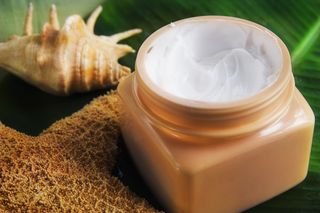The Truth About Cocoa Butter


Almost everybody eats cocoa butter at some point, and a lot of people rub it all over their bodies, too. But what is it exactly, and is it healthy?
First of all, this "butter" doesn't come from a cow. Rather, along with cocoa powder, it is one of the two major products made from the cocoa bean. After farmers extract cocoa beans from the inside of a larger, fleshy cocoa fruit, the beans are cleaned, roasted and then pressed in hydraulic machinery, oozing forth cocoa butter. After the cocoa butter is extracted, the remaining solids are processed into cocoa powder.
Cocoa butter and powder, separated at birth, are reunited to make chocolate, along with sugar and milk, according to taste. That is, most of the ingredients for necessary for chocolate are present in the cocoa bean in the first place, which is a bit unusual – imagine making apple pie using only apples and their seeds.
Most of chocolate's color, flavor, beneficial chemicals, and caffeine come from the cocoa powder. But cocoa butter, which appears off-white or light beige on its own, is responsible for chocolate's bulk and consistency.
Composed of a combination of fats that is solid at room temperature, but liquid at human body temperature, cocoa butter is the reason that chocolate literally melts in your mouth (and sometimes your pockets). It's also resistant to oxidation, which means it helps chocolate to not become rancid.
Even if cocoa butter is the silent partner in the powder-butter duo, it's far from inactive in the body. Cocoa butter consists mainly of palmitic, stearic, and oleic acids. Palmitic acid, a solid, saturated fat, increases risk of cardiovascular disease. Stearic acid, which is also a solid, saturated fat, appears to have a neutral effect, which is uncommon among saturated fats. Oleic acid, meanwhile, is a liquid, monounsaturated fat that decreases the risk of heart disease.
Very generally speaking, unhealthy fatty acids tend to be solid at room temperature, while healthier fatty acids tend to be found in the liquid state. The net effect of the fatty acids in cocoa butter is that it has little effect on heart health per se, although it does deliver a serious caloric punch, only worsened by the milk and sugar that are often added to chocolate.
Sign up for the Live Science daily newsletter now
Get the world’s most fascinating discoveries delivered straight to your inbox.
So, to get the best health bang for your caloric buck from chocolate, eat small amounts of dark chocolate – the more cocoa powder per gram, the better.
But use of cocoa butter isn't restricted to chocolate, or even to food. It's also a very common ingredient in skin creams and moisturizers. While it's reputed to prevent or remove stretch marks that can come with pregnancy or weight gain, a recent study has suggested that it's not any more effective than a placebo at stretch mark removal.
Pass it on: Cocoa butter isn't inherently unhealthy, but it will add to your daily caloric intake.
Food Facts explores the weird world of the chemicals and nutrients found in our food, and appears on MyHealthNewsDaily on Fridays. Follow MyHealthNewsDaily on Twitter @MyHealth_MHND. We're also on Facebook & Google+.
Read more Food Facts columns:
